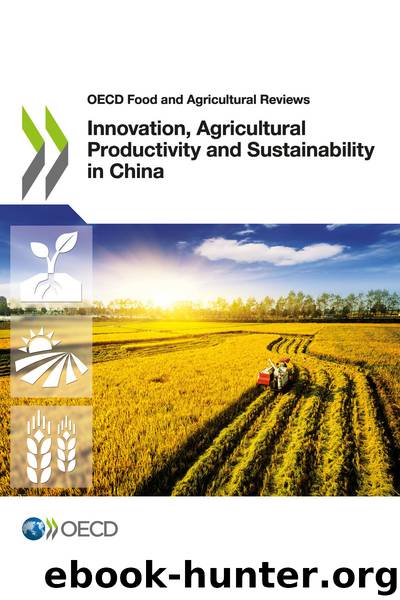Innovation, Agricultural Productivity and Sustainability in China by OECD

Author:OECD
Language: eng
Format: epub
Tags: science/industry/agriculture
Publisher: OECD Publishing
Published: 2018-10-03T16:00:00+00:00
Conservation of farmland
Land is a scarce resource in China and the country’s rapid economic growth has increased competition between agricultural and other land use. Arable land area declined an average of 500 000 hectares per year between 1997 and 2013; in the early 2000s, the area of converted arable land exceeded 1% of the total area, but the majority of this was converted to ecological use such as forests and grasslands (Figure 4.4). However, Kong (2014) finds that around 3 million hectares of high-quality arable land and 1 million hectares of paddy land were converted to urban use in just over a decade, and more than 3 million hectares of farmland suffered from environmental degradation. It is often the case that arable land plots favourable for agricultural production are also suitable for construction use because of their good road access, and the flat and square shape of the plot.
China places the preservation of high-quality arable land high on its policy agenda. It has also set a “red line” for the protection of certain areas of farmland (permanent basic farmland) as a result of national food security concerns. The Outline of the National Overall Planning on Land Use (2006-2020) aims to preserve 1.805 billion mu (120 million hectares) of arable land, including 1.546 billion mu (104 million hectares) of basic agricultural land. It also limits the conversion of arable land to construction land to 45 million mu (3 million hectares) in total by 2020. The Outline also includes the target of preserving ecological land. Alongside the protection of arable land, “basic ecological land” is strictly protected to ensure that cultivated land, orchards, forests, pastureland, water areas, and certain unutilised land that have ecological functions have to exceed 75% of the total national land area. The Outline strengthens the ecological function of land, including maintenance of the retirement of certain cultivated land, the ecological rehabilitation and reclamation of wasteland from mining activities, and the prevention and treatment of degraded land.
Given the scarcity of land in China and the higher return on industrial or residential use of land, the conversion of agricultural land to non-agricultural use is inevitable. The conversion of land use may contribute to the diversification of economic activity in rural areas. The land use policy should prioritise the conservation of high-quality farmland and concentrates agricultural investment to such area. They should also guide the conversion of farmland to other purposes based on a clear land use plan at the local level.
The geographical distribution of agricultural production has been rationalised over the past three decades, reflecting the production conditions of different regions. For example, rice production has been concentrating in northern China, mainly in Northeast China. The 2017 No. 1 Document proposed to establish functional zones for production of rice, wheat and corn, and production protection zones for soybean, cotton, rapeseed, sugar cane, and rubber, which concentrate infrastructure investment and subsidy programmes. In April 2017, the State Council issued a guideline establishing these functional and protection zones.
Download
This site does not store any files on its server. We only index and link to content provided by other sites. Please contact the content providers to delete copyright contents if any and email us, we'll remove relevant links or contents immediately.
| Automotive | Engineering |
| Transportation |
Whiskies Galore by Ian Buxton(41783)
Introduction to Aircraft Design (Cambridge Aerospace Series) by John P. Fielding(33039)
Small Unmanned Fixed-wing Aircraft Design by Andrew J. Keane Andras Sobester James P. Scanlan & András Sóbester & James P. Scanlan(32723)
Craft Beer for the Homebrewer by Michael Agnew(18117)
Turbulence by E. J. Noyes(7915)
The Complete Stick Figure Physics Tutorials by Allen Sarah(7283)
Kaplan MCAT General Chemistry Review by Kaplan(6847)
The Thirst by Nesbo Jo(6795)
Bad Blood by John Carreyrou(6514)
Modelling of Convective Heat and Mass Transfer in Rotating Flows by Igor V. Shevchuk(6374)
Learning SQL by Alan Beaulieu(6188)
Weapons of Math Destruction by Cathy O'Neil(6110)
Man-made Catastrophes and Risk Information Concealment by Dmitry Chernov & Didier Sornette(5896)
Digital Minimalism by Cal Newport;(5623)
Life 3.0: Being Human in the Age of Artificial Intelligence by Tegmark Max(5438)
iGen by Jean M. Twenge(5348)
Secrets of Antigravity Propulsion: Tesla, UFOs, and Classified Aerospace Technology by Ph.D. Paul A. Laviolette(5286)
Design of Trajectory Optimization Approach for Space Maneuver Vehicle Skip Entry Problems by Runqi Chai & Al Savvaris & Antonios Tsourdos & Senchun Chai(4988)
Electronic Devices & Circuits by Jacob Millman & Christos C. Halkias(4886)
